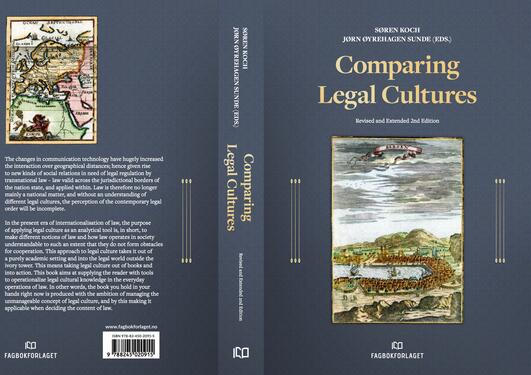Literature and other sources
In the past ten years, the members of the research group have published several key textbooks within the group's thematic focus areas: Legal culture, legal history and comparative law.

Main content
Literature
Comparing Legal Cultures. Sören Koch and Jørn Øyrehagen Sunde (eds.) (2020)

A textbook about comparing legal cultures edited by Sören Koch and Jørn Øyrehagen Sunde, the newest edition from 2020.
Comparing Legal Cultures is Norway's newest and most frequently used textbook in comparative law, and shows the strong connection between research and education. Both members and associated members of the research group has contributed in the making of the book, and it is therefore one of many products resulting from the research group's collaborations. The book identifies and explains the special legal historical features of fifteen different legal cultures, and contributes in that manner to create an understanding in regard to challenges on the internationalisation of law, legal pluralism and opposition to such tendencies in society and among legal scholars.
For more information see the publisher's website.
Lærebok i forfatningshistorie. Dag Michalsen and Eirik Holmøyvik (2015)

A textbook about constitutional history by Dag Michalsen and Eirik Holmøyvik, from 2015.
The book Lærebok i forfatningshistorie is written by Eirik Holmøyvik and Dag Michalsen. The book is written with the purpose of providing law students with insight in Norwegian constitutional history. The book is funded on research on constitutional history.
The textbook on constitutional history provides a thorough introduction to Norwegian constitutional history from 1814 to the present day. An important ambition is to present the Norwegian constitutional development in light of international contexts and trends. The starting point is the modern constitution and its emergence around 1800 based on natural law and the constitutional theories of the Enlightenment. The Norwegian Constitution of 1814 was part of this international constitutional movement. The book explains the creation and content of the Constitution historically and comparatively. The Norwegian constitutional development after 1814 is illuminated through changes to the Constitution and changing interpretations in key areas such as the separation of powers and state sovereignty, the political and constitutional consequences of the union with Sweden between 1814 and 1905, the emergence and development of the courts' power of review over laws, and the significance of the Constitution in times of crisis and emergency.
For more information see the publisher's website.
Speculum legale - rettsspegelen. Jørn Øyrehagen Sunde (2005)

A textbook about norwegian legal history by Jørn Øyrehagen Sunde, from 2005.
Speculum legale - Rettsspegelen aims to be a textbook on the history of Norwegian legal culture in a European perspective by presenting legal history as a mirror that allows reflection on the law as it exists today and its potential for future changes.
One learns through experience. Legal history is the collective memory of law and legal science, enabling legal subjects and the professional actors of the law to draw on past experiences. In this sense, legal history is the steady foundation of a law that is constantly changing at all levels. Law can be compared to an ocean: on the surface, there are laws and legal rules, at an intermediate level, there are legal principles such as the obligation to uphold contracts, while at the ocean floor, there are legal fundamental beliefs like the autonomous individual. Together, these three levels constitute legal culture. By making legal culture the object of legal history, one can place law within a comprehensive structure so that the connection between law as intellectual activity and craftsmanship, between major philosophical ideas and concrete legal decisions, becomes clear.
Intellectual goods, such as ideas and beliefs, travel as easily over geographical distances as material goods, and new methodological approaches spread as quickly as technical innovations. It is within the framework of the nation that law takes shape as legal subjects create customs, legal practices establish precedents, and through legislation. This means that the law must be understood within both a national and an international context.
For more information see the publisher's website.
Rett - En internasjonal historie. Dag Michalsen (2023)

A textbook about 'the law - an international history' by Dag Michalsen, from 2023.
Law is an international phenomenon. How did law develop in different societies over time?
In this book, Professor of Legal History Dag Michalsen traces the long lines of international legal history from antiquity to the present day. He examines Roman law, Islamic law, royal legislation in the Middle Ages, natural law, and constitutions on all continents up to today's EU law.
What legal features did the medieval kingdom or international law have from the 1600s? And what role did the invention of the modern joint-stock company play in the development of the modern economy? Such and many other questions are discussed. Norwegian legal history is woven into the fabric of international legal history.
For more information see the publisher's website.
Fordom og forventning. Jørn Øyrehagen Sunde (eds.) (2019)

A manual on methodological tools when studying legal history edited by Jørn Øyrehagen Sunde, from 2019.
The object of the book is to provide methodological tools when studying legal history. The reflections of eight legal historians provide the basis of the book.
For more information see the publisher's website.
Rendezvous of European Legal Cultures. Jørn Øyrehagen Sunde and Knut Einar Skodvin (red.) (2010)

A textbook about comparative law edited by Jørn Øyrehagen Sunde and Knut Einar Skodvin, from 2010.
The book Rendezvous of European Legal Cultures is developed in collaboration between Jørn Øyrehagen Sunde and Knut Einar Skodvin, specifically written for students in comparative law.
Law is culture in that it is not only a matter of statutes and enforcement bodies but also of ideas and expectations. These are continuously altered through observations of foreign law. One can thus say that all European legal cultures are essentially blended legal cultures, and that the meeting between the foreign and the familiar constitutes the core of a legal culture. This means that the internationalization of law is not something new. At the same time, the scope and pace are rarely significant because different legal cultures meet in the Human Rights and ECtHR courts. This is the theme of "Rendezvous of European Legal Cultures," along with how Nordic and Sami legal cultures position themselves in relation to national and European legal cultures.
For more information see the publisher's website.
Springer Handbook for Legal Cultures. Sören Koch and Marius Mikkel Kjølstad (2023)

A textbook about comparing legal cultures, written by Sören Koch and Marius Mikkel Kjølstad, in 2023.
The book Springer Handbook for Legal Cultures. A Selection of the World's Legal Cultures was first published by Springer Nature in 2023. The book provides the first systematic overview of selected legal cultures. The book is based on a different classification system than the classic distinction between common and civil law, and thus enables legal cultural comparison.
For more information about the book see here.
Kongen, lova og landet. Jørn Øyrehagen Sunde (2023)

This book is about King Magnus 6., also known as Magnus Lagabøter.
1000 år med norsk rettshistorie. Jørn Øyrehagen Sunde (2023)

This book is about the history of norwegian law, with particular focus on how the law was changed through new communication technologies.
Frederik Stangs naturrett. Marius Mikkel Kjølstad (2023)

Frederik Stang was one of the most central political figures in Norway in the 19th century, primarily as a minister for almost 30 years. What did Stang think society should look like? His lectures on natural law from 1830 to 1831 give us a good insight. In this book, the lectures are published in a transcribed version. We learn what Stang thought about, among other things, philosophy, the essence of man, the task of the court, property, contracts, marriage and family, punishment, the purpose of the state, distribution of power and democracy. The lectures shed new light on Stang's thinking, but also on the natural law tradition in Norway and the way historians have portrayed Stang afterwards. In the introduction, the book's editor Marius Mikkel Kjølstad argues for a new understanding of the lectures.
Frederik Stang (1808–1884) was a docent and lecturer in jurisprudence from 1830 to 1834. He published a state law book in 1833, which for several decades stood as the leading interpretation of the Constitution. As a minister, he carried out important reform work in many areas of society. Stang helped to strengthen the government's political position, and in 1873 he became the first prime minister in Norway after the office of governor was removed.
Eidsivatinget. Den norske tingtradisjonen gjennom 1000 år. Jørn Øyrehagen Sunde and Brage Thunestvedt Hatløy (2022)

This book is about the legal history of Eidsivatinget.
Høgsteretts historie 1965-2015: at dømme i sidste instans. Jørn Øyrehagen Sunde (2015)

This book is about the legal history of the norwegian Supreme Court between 1965-2015.
Comparative Perspectives in Scottish and Norwegian Legal History, Trade and Seafaring 1200-1800. Jørn Øyrehagen Sunde and Andrew Simpson (2023)

Nordic and Germanic Legal Methods. Sören Koch and Ingvill Helland (2014)

Maktfordeling og 1814. Eirik Holmøyvik (2012)

This book is about the legal history on checks and balances.
Den juridiske komedien. Jørn Øyrehagen Sunde (2007)

This book explores the connection between law and culture.
Other sources
Preserved legal lectures from the 19th century. Marius Mikkel Kjølstad (2023)

By Marius Mikkel Kjølstad, finished in 2023.
Many handwritten legal lecture manuscripts from the 19th century are kept at Norwegian archives, libraries and educational institutions. Such manuscripts can be an important source for legal history research. This overview contains a register of manuscripts held, including manuscript references and information about material that has been digitized and transcribed. The overview was prepared in 2023 by Marius Mikkel Kjølstad, who is a research fellow in legal history at the Faculty of Law, University of Bergen.
The overview is structured chronologically according to lecturers from 1814 up to and including those who began their lecturing activities before 1900. Manuscripts with unknown lecturers are collected towards the end of the overview.
The entire overview can also be downloaded as a separate document, attached below.
(NB = National Library, RA = National Archive, UiO UJUR = Law Library)
More



